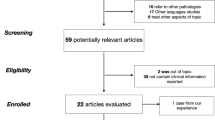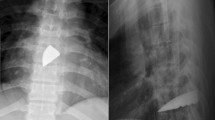Abstract
Purpose
To describe the profile and determine the risk factors for the development of intracranial infections (ICI) in paediatric patients with myelomeningocele (MMC).
Methods
Retrospective analysis of data from the records of patients with MMC admitted into our hospital between January 2006 and December 2015.
Results
We managed a total of 688 paediatric non-trauma neurosurgical patients in our facility during the study period. 29.4% of these patients had MMC. We found the records for 49% of the patients. The male: female ratio was 1.3:1. Most of the MMCs were located in the lumbosacral region (71.7%). The lesion was ruptured in 42.4%, unruptured in 53.5%, and indeterminate in 4.0% of the patients. 48.5% of the MMCs were infected at presentation. Surgical repair of the spinal dysraphism was performed in 74.7% of the patients. Postoperative complications observed in our series include wound dehiscence, cerebrospinal fluid leak, and pseudomeningocele which occurred in 13.5%, 12.2%, and 2.7% of the operated cases of MMC respectively. 28.3% of the patients with MMC developed ICI during the course of hospitalization. 71.4% of patients with MMC-associated ICI had septic neural placode at the initial clinical evaluation. 70% of the patients who had wound dehiscence post-operatively developed ICI. Loculations and abscesses occurred only in patients who had surgical repair. A multivariate logistic regression analysis revealed that septic neural placode, hydrocephalus, a supra-lumbar location of the MMCs and surgical intervention were predictive of ICI (p < 0.05).
Conclusion
Infection of the neural placode, hydrocephalus, locations of the lesions above the lumbar region, and surgical repair were the statistically significant risk factors for ICI in our study population. The trending but statistically insignificant risk factors for ICI in our series may require further assessment with a larger sample size.




Similar content being viewed by others
References
Abubakr DS, Mohammed AE, Alla AM (2014) Spina bifida in Sudan. J Neurol Neurosci 5:1–8. https://doi.org/10.3823/344
Najat F, Baradaran N, El Khahab M (2011) Large myelomeningocele repair. Indian J Plast Surg 44:87–90
Kaplan M, Ulcer N, Bayrakli F, Duz B, Erol FS (2010) Diagnosis of central nervous system infection by CSF sampling of the myelomeningocele sac as an alternative to ventricular tap. Neurocirugia (Astur) 21:228–231
Caldarelli M, Di Rocco C, La Marca F (1996) Shunt complications in the first postoperative year in children with meningomyelocele. Childs Nerv Syst 12:748–754
Gamache FW (1995) Treatment of hydrocephalus in patients with meningomyelocele or encephalocele: a recent series. Childs Nerv Syst 11:487–488
McLone DG, Dias MS (1991) Complications of myelomeningocele closure. Pediatr Neurosurg 17:267–273
Rennie JM (1999) Central nervous system malformation. In: Rennie JM, Roberton MRC (eds) Textbook of neurology, 3rd edn. Churchill Livingstone, Edinburgh, pp 1297–1311
Asindi A, Al-Shehri A (2001) Neural tube defects in the Asir region of Saudi Arabia. Ann Saudi Med 21:26–29
Carter CO (1974) Clues to the aetiology of neural tube malformations. Dev Med Child Neurol 16:3–15
Food and Drug Administration (1996) Food standards: amendment of standards of identity for enriched grain products to require addition of folic acid. Fed Register 61:8781–8797
Adeleye AO, Olowookere KG (2009) Central nervous system congenital anomalies: a prospective neurosurgical observational study from Nigeria. Congenit Anom (Kyoto) 49:258–261
Gedefaw A, Teklu S, Tadesse BT (2018) Magnitude of neural tube defects and associated risk factors at three teaching hospitals in Addis Ababa, Ethiopia. Biomed Res Int. https://doi.org/10.1155/2018/4829023
Benclowe H, Kancherla V, Moorthie S, Darlison M, Modell B (2018) Estimates of global and regional prevalence of neural tube defects for 2015: a systematic analysis. Ann N Y Acad Sci 1414:31–46. https://doi.org/10.1111/nyas.13548
Sever LE, Lowell E, Sanders M, Monsen R (1982) An epidemiologic study of neural tube defects in Los Angeles County I. prevalence at birth based on multiple sources of case ascertainment. Teratology 25:315–321
Liptak GS, Dosa NP (2010) Myelomeningocele. Pediatr Rev 31:443–450. https://doi.org/10.1542/pir.31-11-443
Alatise OI, Adeolu AA, Komolafe EO, Adejuyigbe O, Sowande OA (2006) Pattern and factors affecting management outcome of spina bifida cystica in Ile-Ife, Nigeria. Pediatr Neurosurg 42:277–283
Öktem IS, Menku A, Özdemir A (2008) When should ventriculoperitoneal shunt placement be performed in cases with myelomeningocele and hydrocephalus? Turk Neurosurg 18:387–391
Uba AF, Isamade ES, Chirdan LB, Edino ST, Ogbe ME, Igun GO (2004) Epidemiology of neural tube defects in north Central Nigeria. Afr J Paediatr Surg 1:16–19
Lorber J (1961) Systematic ventriculographic studies in infants born with meningomyelocele and encephalocele. The incidence and development of hydrocephalus. Arch Dis Child 36:381–389
Katikar DB, Jaykar RD, Kamble M, Agrawal S (2014) Study of surgical intervention in patient of Meningocele with hydrocephalus: simultaneous V/S sequential group. Int J Recent Trends Sci Technol 11:17–24
Haslam RHA (2000) Congenital anomalies of the central nervous system. In: Behrman RE, Kliegman RM, Jenson HB (eds) Nelson textbook of pediatrics, 16th edn. WB Saunders Co, Philadelphia, pp 1803–1810
Hashim SM, Ahmed S, Jooma R (2008) Management of myelomeningocele. J Surgery Pakistan 13:7–11
Halaby WE, Ismail MT (2016) Delayed hydrocephalus after repairing un- rupture Myelomeningocele. Egypt J Neurosurg 31:167–170
Shehu BB, Ameh EA, Ismail NJ (2000) Spina bifida cystica: selective management in Zaria, Nigeria. Ann Trop Paediatr 20:239–242
Guthkelch AN, Pang D, Vries JK (1981) Influence of closure technique on results in myelomeningocele. Childs Brain 8:350–355
Brau RH, Rodríguez R, Ramírez MV, González R, Martínez V (1990) Experience in the management of myelomeningocele in Puerto Rico. J Neurosurg 72:726–731
Charney EB, Melchionni JB, Antonucci DL (1991) Ventriculitis in newborns with myelomeningocele. Am J Dis Child 145:287–290
Seidel SB, Gardner PM, Howard PS (1996) Soft-tissue coverage of the neural elements after myelomeningocele repair. Ann Plast Surg 37:310–316
Ammirati M, Raimondi AJ (1987) Cerebrospinal fluid shunt infections in children. A study on the relationship between the etiology of the hydrocephalus, age at the time of shunt placement, and infection rate. Childs Nerv Syst 3:106–109
Author information
Authors and Affiliations
Corresponding author
Ethics declarations
Conflict of interest
The author declares that they have no conflict of interest.
Additional information
Publisher’s note
Springer Nature remains neutral with regard to jurisdictional claims in published maps and institutional affiliations.
Rights and permissions
About this article
Cite this article
Anegbe, A.O., Shokunbi, M.T., Oyemolade, T.A. et al. Intracranial infection in patients with myelomeningocele: profile and risk factors. Childs Nerv Syst 35, 2205–2210 (2019). https://doi.org/10.1007/s00381-019-04219-8
Received:
Accepted:
Published:
Issue Date:
DOI: https://doi.org/10.1007/s00381-019-04219-8




